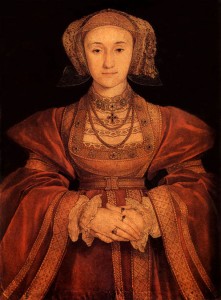After a brief hiatus, Fancy Friday is back and better than ever with this week’s contender, Hans Holbein’s Anne of Cleves!
As the last Fancy Friday honoree was the portrait from Holbein’s workshop of Henry VIII, we thought it was only fair to honor a portrait of one of Henry’s wives. He did have six of them, after all. So why not give Holbein the credit he deserves for painting a portrait of one of these queens?

Anne of Cleves was Henry VIII’s fourth wife. According to tudorhistory.org, she was born to a noble family in the Holy Roman Empire in 1515. After Henry’s third wife, Jane Seymour, died of complications from childbirth in 1537, the king’s advisors began searching for an eligible bachelorette to become his next wife, as Henry was still without an heir. Finding someone who the king actually loved seemed to be of little importance, as Henry needed a marriage of alliance with another region that had chosen to split with papal authority. Anne, the sister of the Duke of Cleves of the Holy Roman Empire, seemed to be a fitting match. But to be sure, court painter Hans Holbein the Younger was sent to paint a portrait of Anne for King Henry.
In the portrait, we see a lovely Anne in all her #fancy splendor. Her hair is done up in an elaborate headdress, the most fashionable style for the Holy Roman Empire for the day, and the jewels embedded in her ornate dress hint at her wealth. It’s obvious that she’s wearing her fanciest Sunday best for this portrait. She’s characterized as devoted to her Lutheran religion by the cross on her necklace. Seriously, her bling is enough to make 2 Chainz jealous. Anne looks to be one of the fairest maidens of the 1500s, as she conforms exactly with that era’s standards of beauty–pale skin, a high forehead, and rosy lips. But her eyes are looking straight at us, as if to hint at her awareness. She knows we’re looking at her.
History leads us to wonder if Anne was really as beautiful as her portrait suggests. Holbein may have done his job too well, because upon meeting Anne, Henry was reported to have said the Tudor equivalent of “You don’t look like your profile picture.” Which is ironic, since Henry himself wasn’t much of a looker by that point (or ever, really). After meeting her, Henry tried to annul the betrothal, but failed. They were married in January of 1540. It didn’t last long–Henry annulled the marriage in July of the same year. Anne, however, was smart enough to realize that fighting the divorce would probably get her killed, and so went along with it. She was given property (including a castle) and continued to live her life in the English countryside, a move that allowed her to outlive the rest of Henry’s wives.
What’s most striking about the Holbein portrait is that it communicates Anne’s intelligence. Many portraits of the other Tudor women don’t depict them as looking straight at the viewer, because this might have been seen as improper. Not Anne. Holbein’s decision to paint her with this eyes on us might have been an attempt to capture her intelligence rather than characterize her as having loose morals. Especially because Henry was looking for a political marriage, not necessarily one of mutual attraction. So perhaps Holbein is trying to communicate some of Anne’s street-smarts that allowed her to avoid a beheading by her husband. That and the fact that she’s #fancy as all get-out.
Or perhaps, as The Guardian suggests, Holbein was attempting to engineer the union of Anne and Henry himself and subtly declare the power he had as an artist. Take a look here for this interesting read on Holbein’s portrait!
Want more Tudor history? Check out tudorhistory.org here for more info on Anne of Cleves and the rest of Henry VIII’s wives.







